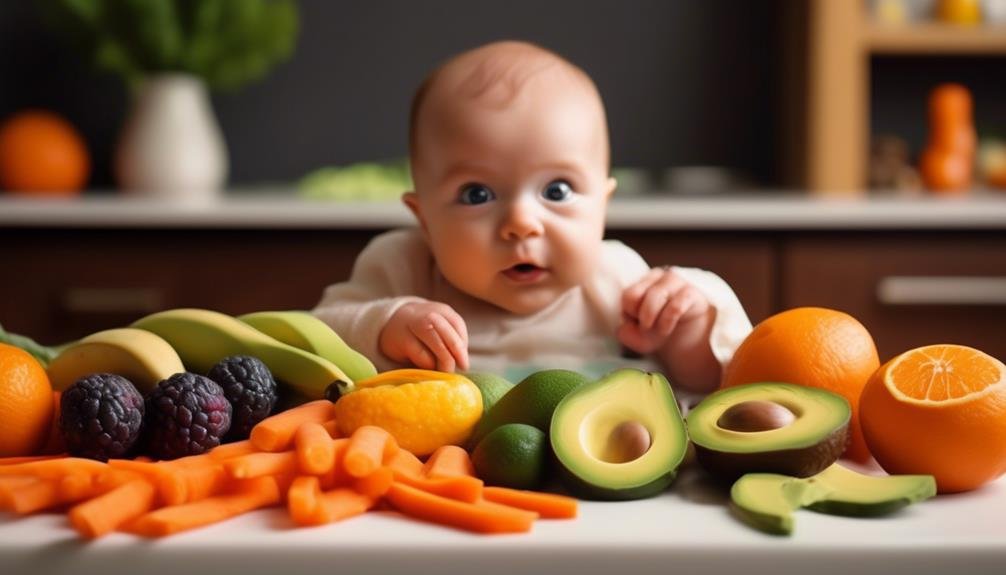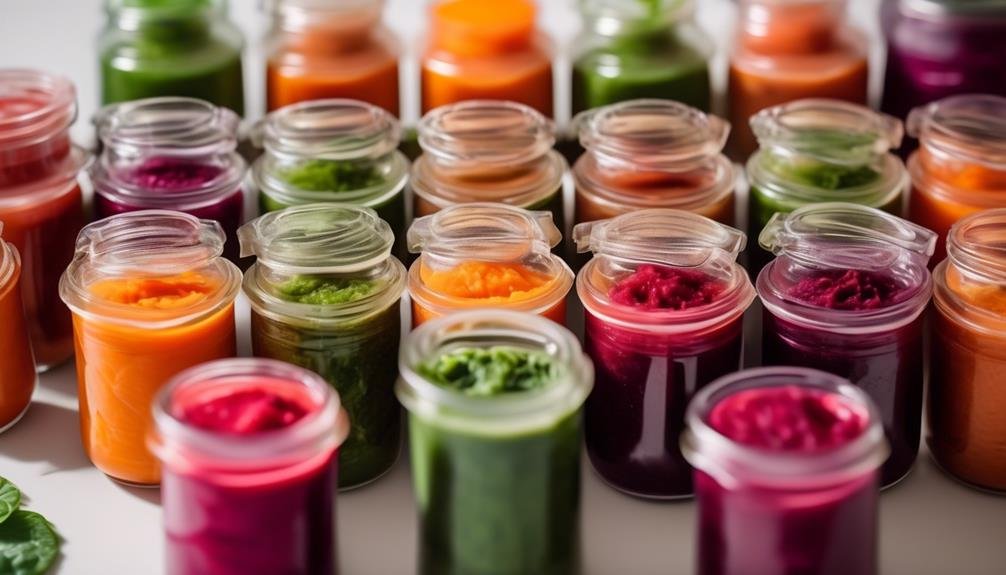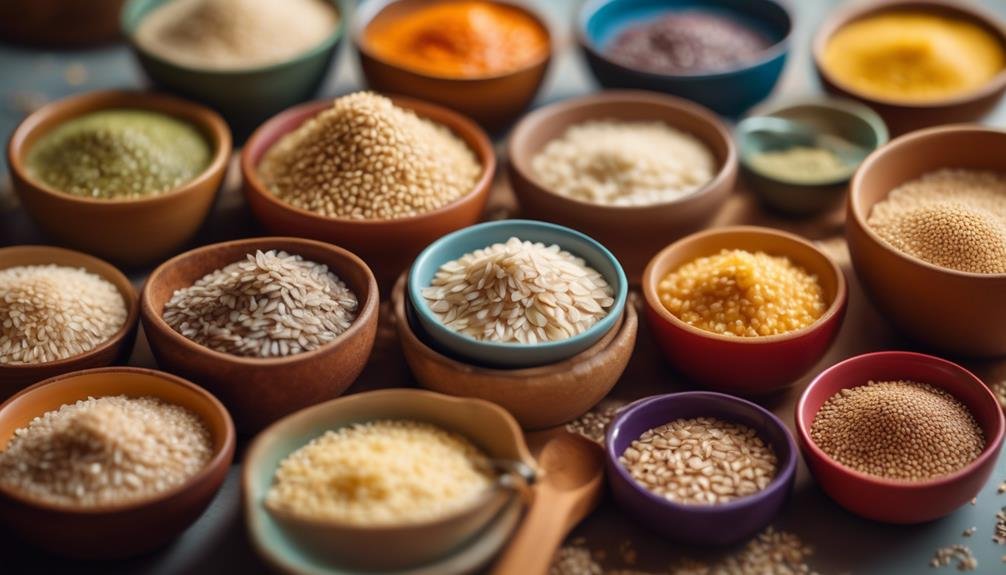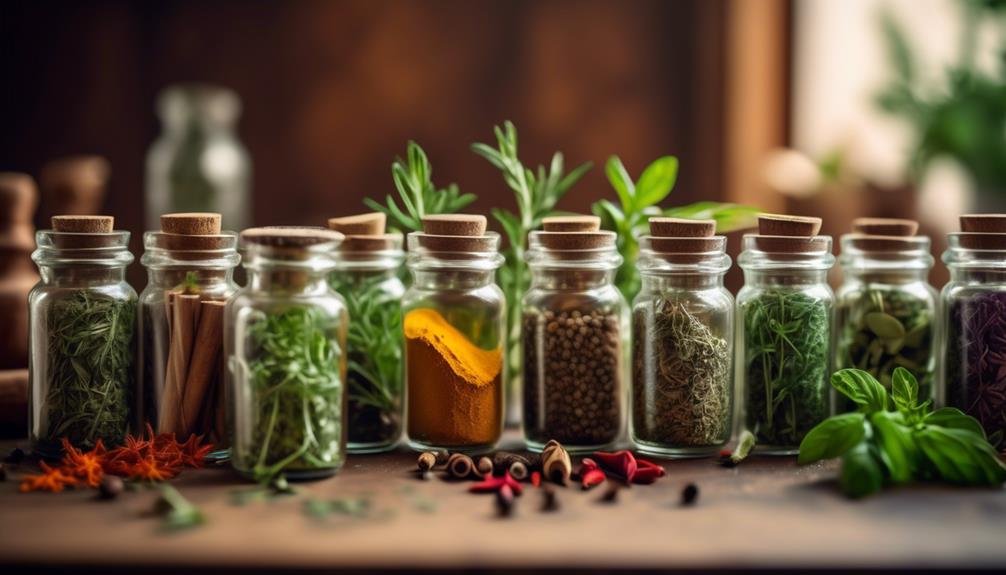"Cherishing Little Steps - A Haven for Baby and Family Journeys"
Homemade Purees for Babies
Are you a new parent looking for the best way to nourish your baby? Look no further than homemade purees.
But why choose homemade over store-bought options? Well, not only do homemade purees allow you to have complete control over what goes into your little one's food, but they also offer a wide range of flavors, textures, and nutrients that are essential for your baby's development.
So, let's explore the world of homemade purees together and discover how you can provide your baby with a nourishing and delicious start to their culinary journey.
Key Takeaways
- Homemade purees allow for complete control over ingredients, avoiding additives, preservatives, and excess sugar.
- Introducing a variety of homemade purees expands a baby's palate and helps customize consistency.
- Homemade purees are cost-effective and sustainable, with essential tools including a blender or food processor, steamer or steaming basket, silicone freezer trays or ice cube trays, high-quality utensils, and storage containers.
- When making homemade purees, it's important to prioritize nutrient-rich options, consider baby-led weaning, offer soft age-appropriate finger foods, continue breastfeeding or formula feeding, and introduce allergenic foods cautiously.
Benefits of Homemade Purees

Making homemade purees for your baby offers numerous benefits that contribute to their overall health and development.
When you prepare baby food at home, you have complete control over the ingredients used, ensuring that your little one receives a nutritious and balanced meal. Commercial baby food often contains additives, preservatives, and excess sugar, which can be avoided by making your own purees.
By introducing a variety of flavors and textures, homemade baby meals can help expand your baby's palate and promote a love for healthy foods from an early age.
Additionally, homemade purees allow you to customize the consistency of the food to match your baby's development stage. This gradual transition helps in developing their chewing and swallowing skills.
Furthermore, making your own baby food can be cost-effective, especially when buying seasonal produce or purchasing in bulk. It also promotes sustainability by reducing packaging waste.
Essential Tools for Making Purees
To make homemade purees for your baby, you'll need a few essential tools. These utensils will make the process easier and more efficient, allowing you to create nutritious and delicious purees for your little one.
Here are the must-have tools for puree preparation:
- Blender or Food Processor: A high-quality blender or food processor is essential for achieving a smooth and consistent texture in your baby's purees. This tool will help you break down fruits, vegetables, and other ingredients into a fine puree that's safe for your baby to consume.
- Steamer or Steaming Basket: Steaming is one of the best methods for preserving the nutrients in fruits and vegetables. A steamer or steaming basket will allow you to gently cook the ingredients before blending them into purees. This ensures that your baby gets the maximum nutritional benefits from their food.
- Silicone Freezer Trays or Ice Cube Trays: These trays are perfect for portioning and freezing your homemade purees. They come with individual compartments, making it easy to store and serve small portions to your baby. Plus, the silicone material makes it effortless to pop out the frozen purees when needed.
Introduction to Baby's First Foods

When introducing your baby's first foods, it's crucial to prioritize nutrient-rich options that align with their stage of development. One approach gaining popularity is baby led weaning, which involves allowing your baby to self-feed from the start. This method encourages the development of hand-eye coordination and promotes self-regulation of appetite.
Begin by offering soft, age-appropriate finger foods such as cooked vegetables, fruits, and whole grains. As your baby explores these new textures, continue to breastfeed or offer formula for adequate nutrition.
When it comes to introducing allergenic foods, recent research suggests that early introduction may actually reduce the risk of developing allergies. You can start with common allergens like peanuts, eggs, and dairy, as long as they're prepared appropriately and your baby doesn't have any existing allergies or medical conditions.
It's recommended to introduce one new food at a time, waiting a few days before introducing another, to monitor for any adverse reactions.
Fruity Delights: Homemade Fruit Purees
Get ready to tantalize your baby's taste buds with delicious and nutritious homemade fruit purees. Introducing your little one to a variety of fruits not only offers a burst of flavors but also provides essential vitamins and minerals for their growing bodies.
Here are three creative fruit combinations to entice your baby's palate:
- Strawberry-Banana Mash: Combining the sweetness of ripe strawberries with the creamy texture of bananas, this puree is a delightful treat for your baby. Strawberries are packed with vitamin C and antioxidants, while bananas provide potassium and fiber.
- Mango-Pineapple Blend: Bring a taste of the tropics to your baby's mealtime with this exotic puree. Mangos are rich in vitamin A and fiber, while pineapples add a tangy twist and are a great source of vitamin C.
- Blueberry-Apple Medley: This antioxidant-rich puree combines the natural sweetness of apples with the vibrant color and health benefits of blueberries. Apples are high in fiber, while blueberries offer a plethora of vitamins and minerals.
Veggies Galore: Homemade Vegetable Purees

Looking to introduce a variety of nutritious vegetables to your baby's diet? Homemade vegetable purees are a fantastic way to do just that. Not only are they packed with essential vitamins and minerals, but they also allow you to get creative with different vegetable combinations.
Here are some tips for introducing vegetables to your little one, especially if they're picky eaters.
Firstly, it's important to start early and offer a wide range of vegetables right from the beginning. This will help develop their taste buds and make them more receptive to different flavors.
Secondly, try mixing vegetables with fruits to create a sweeter taste profile. For example, blending carrots with apples or sweet potatoes with pears can make the puree more appealing to your baby.
When it comes to introducing vegetables to picky eaters, it's all about presentation. Try different textures, such as smooth purees or chunkier mashes, to see what your baby prefers. Additionally, adding a touch of seasoning, like a sprinkle of herbs or a dash of cinnamon, can enhance the flavor and make the puree more enticing.
Protein Power: Homemade Meat and Legume Purees
To provide your baby with essential protein, homemade meat and legume purees are a nutritious option to consider. These homemade baby food recipes offer a range of benefits, from being cost-effective to offering complete control over the ingredients.
Here are three reasons why you should incorporate meat substitutes and legumes into your baby's diet:
- Nutrient-rich: Homemade meat and legume purees are packed with essential nutrients like iron, zinc, and protein. These nutrients are crucial for your baby's growth and development, supporting their muscles, bones, and overall health.
- Allergy prevention: By introducing meat substitutes and legumes early on, you can help reduce the risk of allergies later in life. Starting your baby on a varied diet can help them develop tolerance to different foods and minimize the chances of developing allergies.
- Versatility: Meat substitutes and legumes offer a wide variety of flavors and textures, allowing you to create diverse and exciting meals for your little one. From lentils to tofu, there are endless options to explore and introduce to your baby's palate.
Introducing Grainy Goodness: Homemade Grain Purees

For a wholesome and nutritious addition to your baby's diet, consider introducing homemade grain purees. Introducing grains to babies is an important step in their journey towards a varied and balanced diet. Grain purees offer a range of textures that can help develop your baby's oral motor skills and introduce them to different tastes and flavors.
When it comes to grain puree textures, you have several options to choose from. You can start with a smooth and creamy texture by cooking grains like rice or oats until they're soft and blending them with breast milk or formula. As your baby gets older and more comfortable with solid foods, you can gradually increase the texture by mashing the grains with a fork or leaving them slightly chunky.
Introducing grains to your baby's diet can provide them with essential nutrients like fiber, B vitamins, and minerals. Whole grains, such as quinoa and brown rice, are particularly beneficial as they retain their natural fiber and nutrients. To prepare grain purees for your baby, simply cook the grains according to the package instructions and blend them with a little liquid until you achieve the desired consistency.
Remember to introduce one grain at a time and observe your baby for any signs of allergies or sensitivities. As with any new food, it's important to consult with your pediatrician before introducing grain purees to your baby's diet. With a little creativity and experimentation, you can create delicious and nutritious grain purees that your baby will love.
Adding Healthy Fats: Homemade Avocado and Nut Purees
To continue enhancing your baby's diet with nutritious options, consider incorporating homemade avocado and nut purees, which offer valuable healthy fats to support their growth and development.
Avocados are a fantastic source of healthy fats for your little one. They contain monounsaturated fats, which are important for brain development and overall growth. The creamy texture of avocados makes them easy to puree and serve to your baby. Here are three reasons why homemade avocado purees are a great addition to your baby's diet:
- Brain development: Avocados are rich in omega-3 fatty acids, which are vital for your baby's brain development. These healthy fats help build the neurons and pathways in their brain, ensuring optimal cognitive function.
- Heart health: Avocados are packed with oleic acid, a monounsaturated fat that promotes heart health. Including avocados in your baby's diet can help lower their risk of developing heart disease later in life.
- Nutrient absorption: Avocados contain healthy fats that aid in the absorption of fat-soluble vitamins, such as vitamins A, D, E, and K. Adding homemade avocado purees to your baby's meals can help ensure they receive the maximum nutritional benefit from their food.
In addition to avocados, you can also introduce homemade nut purees to provide a variety of healthy fats. Nut butters, such as almond or cashew butter, are excellent options. However, it's important to avoid whole nuts until your baby is at least one year old, as they can be a choking hazard. Make sure to introduce one nut at a time to watch for any potential allergies.
Spice It Up: Homemade Herb and Spice Purees

Consider adding homemade herb and spice purees to your baby's meals for a flavorful and nutritious twist. Introducing different flavors to your baby's diet not only expands their palate but also exposes them to a variety of health benefits. When it comes to herb and spice combinations, there are endless possibilities to explore.
One popular combination is basil and garlic. Basil adds a fresh and aromatic taste, while garlic brings a savory kick. This combination can be added to purees made with vegetables like carrots or potatoes to enhance their natural flavors.
Another delicious option is cinnamon and nutmeg. These warm spices create a comforting and slightly sweet taste. They pair well with purees made from fruits like apples, pears, or sweet potatoes.
If you want to introduce a hint of spiciness, try combining cumin and paprika. These spices add depth and a subtle heat to purees made with beans or lentils.
Remember to start with small amounts of herbs and spices and gradually increase as your baby grows older and becomes more accustomed to different flavors. Always consult with your pediatrician before introducing new ingredients to your baby's diet to ensure they're developmentally ready for them.
Homemade Puree Storage and Safety Tips
When storing homemade purees for your baby, ensuring proper storage and following safety guidelines is crucial. Here are some homemade puree storage options and safety guidelines for preparing homemade purees:
- Refrigeration: After preparing the puree, transfer it into small airtight containers or ice cube trays. Place them in the refrigerator and use within 48 hours. This method allows for easy portioning and quick access to fresh purees.
- Freezing: If you want to store purees for a longer period, freezing is a great option. Pour the puree into ice cube trays or silicone baby food storage containers. Once frozen, transfer the cubes or containers into labeled freezer bags. Remember to date the bags and use the purees within three months to maintain freshness and nutritional value.
- Thawing and reheating: When it's time to use the frozen purees, thaw them overnight in the refrigerator or use the defrost setting on your microwave. Avoid thawing purees at room temperature, as it can promote bacterial growth. Reheat the purees by placing the desired amount in a microwave-safe dish and heating it in short intervals, stirring in between, until warm but not hot.
Frequently Asked Questions
How Can I Introduce Homemade Purees to My Picky Eater?
Encourage your picky eater to try new foods by presenting homemade purees in creative ways. Make it fun and engaging by using colorful bowls, cute utensils, and involving them in the preparation process.
Can I Mix Different Fruits and Vegetables Together to Create Unique Flavors for My Baby?
You can absolutely mix different fruits and vegetables together to create a symphony of flavors for your little one. Not only will it expand their palate, but homemade purees also provide numerous health benefits.
Are There Any Specific Fruits or Vegetables That I Should Avoid When Making Homemade Purees?
When making homemade purees for your baby, it's important to know which fruits and vegetables to avoid. Some examples include honey, citrus fruits, and raw spinach. Following safety precautions ensures your baby's well-being.
Can I Freeze Homemade Purees to Use at a Later Time?
Yes, you can freeze homemade purees for later use. Freezing them preserves the nutrients and saves you time. Just make sure to store them in airtight containers or ice cube trays for easy portioning.
How Long Can I Store Homemade Purees in the Refrigerator Before They Go Bad?
You can store homemade purees in the refrigerator for up to three days before they go bad. Make sure to keep them in airtight containers to maintain their freshness and quality.
Conclusion
In conclusion, homemade purees are a practical and evidence-based option for introducing your baby to solid foods. By using essential tools and following proper storage and safety tips, you can easily prepare a variety of nutritious fruit, vegetable, grain, avocado, nut, herb, and spice purees.
These purees not only provide essential nutrients for your baby's growth and development but also offer a visual feast of fruity delights and veggies galore.
So get creative in the kitchen and give your little one a tasty start to a healthy lifestyle.



Terriufic article! This iis tthe kihd of infoo thwt are meant to be sharded around thhe
internet. Shamme on Googlee for noot positioning
this publish higher! Come onn ovver and talk oveer witth mmy
website . Thanks =)